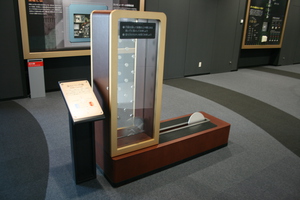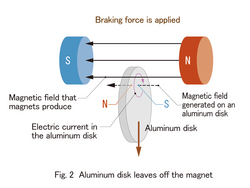Nagoya City Science Museum
TOP > Exhibition Guide > Keyword Search > Starting with "E" > electromagnetism > Eddy Current
Eddy Current

Purpose of Exhibition
Drop an aluminum disk between two sheets. Strong magnets are attached to the sheets at several places from the outside. In a normal situation, the disc drops like a stone, but the disk dropping speed will decrease at the magnets locations.
Even though the aluminum does not adhere to the magnet, in this exhibit you can understand how aluminum and magnets affect each other adversely. When the aluminum moves close to the magnet, a current called the eddy current is generated in the aluminum. Depending on the magnet which is attached to the magnetic force and the plate by this electric current, the magnets and sheets are appealed or repealed, and so, they move slowly.
In this exhibit, you can understand the phenomenon of the eddy current by the movement of the aluminum disk.


Additional Knowledge
Electricity flows through metals such as aluminum and copper.
But metals don't adhere to magnets. However, this situation can differ in the case of motion.
For example, place a 100% aluminum one yen coin on a desk and hold in your hand a strong magnet.
When moving the magnet horizontally over the coin and close to it, the coin moves toward adhering to the magnet.
In addition, place an aluminum pipe vertically on the ground, put a strong magnet inside, and it slowly drops onto the ground.
Instead of an aluminum pipe, do the same thing using a polyvinyl chloride pipe. Then the magnet will drop like a stone. Even though aluminum does not adhere to magnet, it moves like there is some type of connection with the magnet.
When performing a more careful experiment, when the magnet is close to the aluminum, the aluminum detaches itself from the magnet.
On the contrary, when the magnet is kept away from the aluminum, the aluminum tends to adhere to the magnet.
This phenomenon can be observed in the exhibit.
In this exhibit, a magnet has been fixed, and an aluminum disk is moving.
When the aluminum disk adheres to the magnet, because it receives repelling force from the magnet, it pushes back and a brake is put on the movement.
Conversely, when it is kept away from the magnet, because it receives attractive force from the magnet, it pulls back and a brake is put on the movement. However in both cases, since it does not receive any force from the magnet when stopped, the aluminum falls in accordance with gravity.
When falling by the force of gravity, the aluminum disc falls slowly at a balanced speed of force from the magnet generated by the movement of the aluminum disc.
This phenomenon occurs because current is generated in the aluminum.
At a fixed distance between the aluminum and magnet, that is when both the aluminum and magnet do not move, because current is not generated in the aluminum.
When you change the distance between the magnet and the aluminum, that is, move them away or toward each over, current is generated in the aluminum. This current is called the eddy current. When eddy current is generated, this current creates a magnetic force. This magnetic force attracts or repulses the magnet.
Therefore, the movement of the aluminum is altered.
[An aluminum disk and a plastic disk]
Insert the aluminum disk and the plastic disk into the slit one by one to drop inside the box. You will find the difference of dropping speed between them.
Surprisingly, the aluminum one drops more slowly.
As aluminum conducts electricity, eddy current is induced to generate magnetic force. But plastic does not. That is why the difference occurred. There is a close relationship between electricity and magnets.
[Eddy current brake]
In this exhibit, we can understand that a braking force is applied by the utilization of magnets on dropping aluminum sheets. Using this property, railway trains use eddy current brakes. Magnets are installed on discs, which are installed parallel to the wheel. The brake is put on with the disk rotation caused by the generated eddy current.
In addition, eddy current is used in some indoor exercise equipment and exercise bikes as well because of the load on the rotation.
Article by Yoshitaka Yamada, curator
